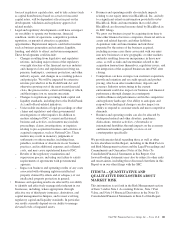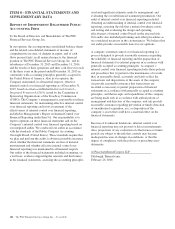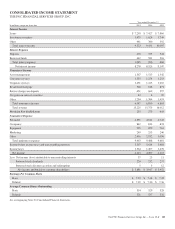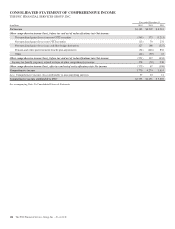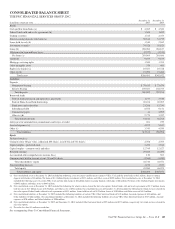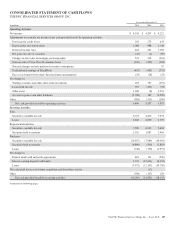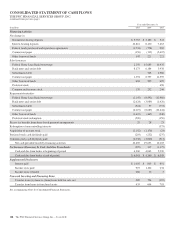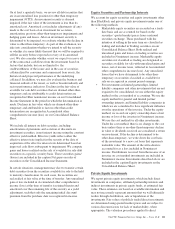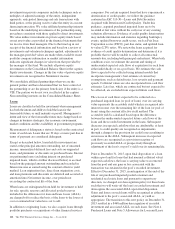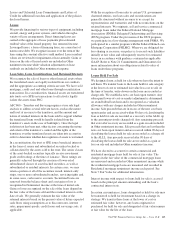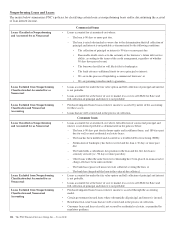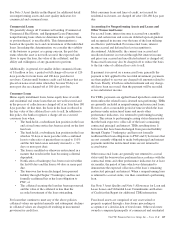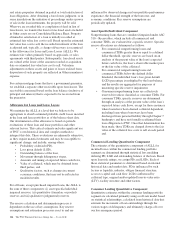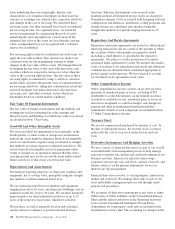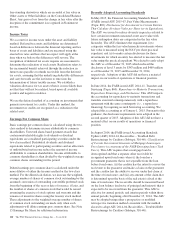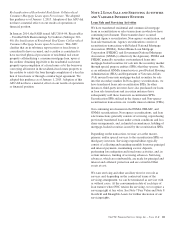PNC Bank 2015 Annual Report Download - page 129
Download and view the complete annual report
Please find page 129 of the 2015 PNC Bank annual report below. You can navigate through the pages in the report by either clicking on the pages listed below, or by using the keyword search tool below to find specific information within the annual report.
On at least a quarterly basis, we review all debt securities that
are in an unrealized loss position for other than temporary
impairment (OTTI). An investment security is deemed
impaired if the fair value of the investment is less than its
amortized cost. Amortized cost includes adjustments (if any)
made to the cost basis of an investment for accretion,
amortization, previous other-than-temporary impairments and
hedging gains and losses. After an investment security is
determined to be impaired, we evaluate whether the decline in
value is other-than-temporary. As part of this evaluation, we
take into consideration whether we intend to sell the security
or whether it is more likely than not that we will be required to
sell the security before expected recovery of its amortized
cost. We also consider whether or not we expect to receive all
of the contractual cash flows from the investment based on
factors that include, but are not limited to: the
creditworthiness of the issuer and, in the case of securities
collateralized by consumer and commercial loan assets, the
historical and projected performance of the underlying
collateral. In addition, we may also evaluate the business and
financial outlook of the issuer, as well as broader industry and
sector performance indicators. Declines in the fair value of
available for sale debt securities that are deemed other-than-
temporary and are attributable to credit deterioration are
recognized in Other noninterest income on our Consolidated
Income Statement in the period in which the determination is
made. Declines in fair value which are deemed other-than-
temporary and attributable to factors other than credit
deterioration are recognized in Accumulated other
comprehensive income (loss) on our Consolidated Balance
Sheet.
We include all interest on debt securities, including
amortization of premiums and accretion of discounts on
investment securities, in net interest income using the constant
effective yield method. Effective yields reflect either the
effective interest rate implicit in the security at the date of
acquisition or the effective interest rate determined based on
improved cash flows subsequent to impairment. We compute
gains and losses realized on the sale of available for sale debt
securities on a specific security basis. These securities gains/
(losses) are included in the caption Net gains on sales of
securities on the Consolidated Income Statement.
In certain situations, management may elect to transfer certain
debt securities from the securities available for sale to the held
to maturity classification. In such cases, the securities are
reclassified at fair value at the time of transfer. Any unrealized
gain or loss included in Accumulated other comprehensive
income (loss) at the time of transfer is retained therein and
amortized over the remaining life of the security as a yield
adjustment, such that only the remaining initial discount/
premium from the purchase date is recognized in income.
Equity Securities and Partnership Interests
We account for equity securities and equity investments other
than BlackRock and private equity investments under one of
the following methods:
• Marketable equity securities are recorded on a trade-
date basis and are accounted for based on the
securities’ quoted market prices from a national
securities exchange. Those purchased with the
intention of selling in the near term are classified as
trading and included in Trading securities on our
Consolidated Balance Sheet. Both realized and
unrealized gains and losses on trading securities are
included in Noninterest income. Marketable equity
securities not classified as trading are designated as
securities available for sale with unrealized gains and
losses, net of income taxes, reflected in Accumulated
other comprehensive income (loss). Any unrealized
losses that we have determined to be other-than-
temporary on securities classified as available for
sale are recognized in current period earnings.
• For investments in limited partnerships, limited
liability companies and other investments that are not
required to be consolidated, we use either the equity
method or the cost method of accounting. We use the
equity method for general and limited partner
ownership interests and limited liability companies in
which we are considered to have significant influence
over the operations of the investee. Under the equity
method, we record our equity ownership share of net
income or loss of the investee in Noninterest income.
We use the cost method for all other investments.
Under the cost method, there is no change to the cost
basis unless there is an other-than-temporary decline
in value or dividends received are considered a return
on investment. If the decline is determined to be
other-than-temporary, we write down the cost basis
of the investment to a new cost basis that represents
realizable value. The amount of the write-down is
accounted for as a loss included in Noninterest
income. Distributions received from the income of an
investee on cost method investments are included in
Noninterest income. Investments described above are
included in the caption Equity investments on the
Consolidated Balance Sheet.
Private Equity Investments
We report private equity investments, which include direct
investments in companies, affiliated partnership interests and
indirect investments in private equity funds, at estimated fair
value. These estimates are based on available information and
may not necessarily represent amounts that we will ultimately
realize through distribution, sale or liquidation of the
investments. Fair values of publicly traded direct investments
are determined using quoted market prices and are subject to
various discount factors for lack of marketability, when
appropriate. The valuation procedures applied to direct
The PNC Financial Services Group, Inc. – Form 10-K 111


